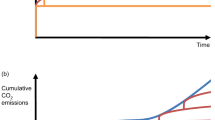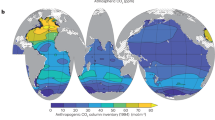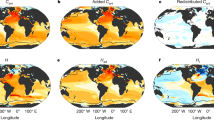Abstract
GLOBAL warming potentials for radiatively active trace gases (such as methane and chlorofluorocarbons) have generally been expressed1–2 relative to the time-integrated climate forcing per unit emission of carbon dioxide. Previous attempts to estimate the integrated climate forcing per unit CO2 emitted have focused on perturbations to steady-state conditions in carbon-cycle models. But for non-steady-state conditions, the integrated climate forcing from a CO2 perturbation depends both on the initial conditions and on future atmospheric CO2 concentrations. As atmospheric CO2concentrations increase, the radiative forcing per unit CO2 emitted will become smaller because the strongest absorption bands will already be saturated. At the same time, higher concentrations of dissolved carbon in the surface ocean will reduce the ocean's ability to absorb excess CO2from the atmosphere. Each of these effects taken alone would affect the climate forcing from a pulse of emitted CO2 by a factor of three or more; but here we show that, taken together, they compensate for each other. The net result is that the global warming potential of CO2 relative to other radiatively active trace gases is nearly independent of the CO2emission scenario. Thus, the concept of the global warming potential remains useful, despite the nonlinearities in the climate system and uncertainties in future emissions.
This is a preview of subscription content, access via your institution
Access options
Subscribe to this journal
Receive 51 print issues and online access
$199.00 per year
only $3.90 per issue
Buy this article
- Purchase on Springer Link
- Instant access to full article PDF
Prices may be subject to local taxes which are calculated during checkout
Similar content being viewed by others
References
Shine, K. P., Derwent, R. G., Wuebbles, D. J. & Morcrete, J.-J. in Climate Change—The IPPC Scientific Assessment (eds Houghton, J. T., Jenkins, G. J. & Elphraums, J. J.) 41–68 (Cambridge Univ. Press, New York, 1990).
Lashof, D. A. & Ahuja, D. R. Nature 344, 529–531 (1990).
Caldeira, K. Globl Biogeochem. Cycles (submitted).
Siegenthaler, U. J. geophys. Res. 88, 3599–3608 (1983).
Stumm, W. & Morgan, J. J. Aquatic Chemistry 2nd edn (Wiley, New York, 1981).
Maier-Reimer, E. & Hasselmann, K. Clim. Dyn. 2, 63–90 (1987).
Killough, G. G. & Emanuel, W. R. Tellus 33, 274–290 (1981).
Hansen, J. et al. J. geophys. Res. 93, 9341–9364 (1988).
Kiehl, J. T. & Dickenson, R. E. J. geophys. Res. 92, 2991–2998 (1987).
Author information
Authors and Affiliations
Rights and permissions
About this article
Cite this article
Caldeira, K., Kasting, J. Insensitivity of global warming potentials to carbon dioxide emission scenarios. Nature 366, 251–253 (1993). https://doi.org/10.1038/366251a0
Received:
Accepted:
Issue Date:
DOI: https://doi.org/10.1038/366251a0
This article is cited by
-
Warming proportional to cumulative carbon emissions not explained by heat and carbon sharing mixing processes
Nature Communications (2023)
-
Xanthan biopolymer-based soil treatment effect on kaolinite clay fabric and structure using XRD analysis
Scientific Reports (2023)
-
The Role of Remaining Carbon Budgets and Net-Zero CO2 Targets in Climate Mitigation Policy
Current Climate Change Reports (2022)
-
Climate economics support for the UN climate targets
Nature Climate Change (2020)
-
Formulation and application of quantum-inspired tidal firefly technique for multiple-objective mixed cost-effective emission dispatch
Neural Computing and Applications (2020)
Comments
By submitting a comment you agree to abide by our Terms and Community Guidelines. If you find something abusive or that does not comply with our terms or guidelines please flag it as inappropriate.



